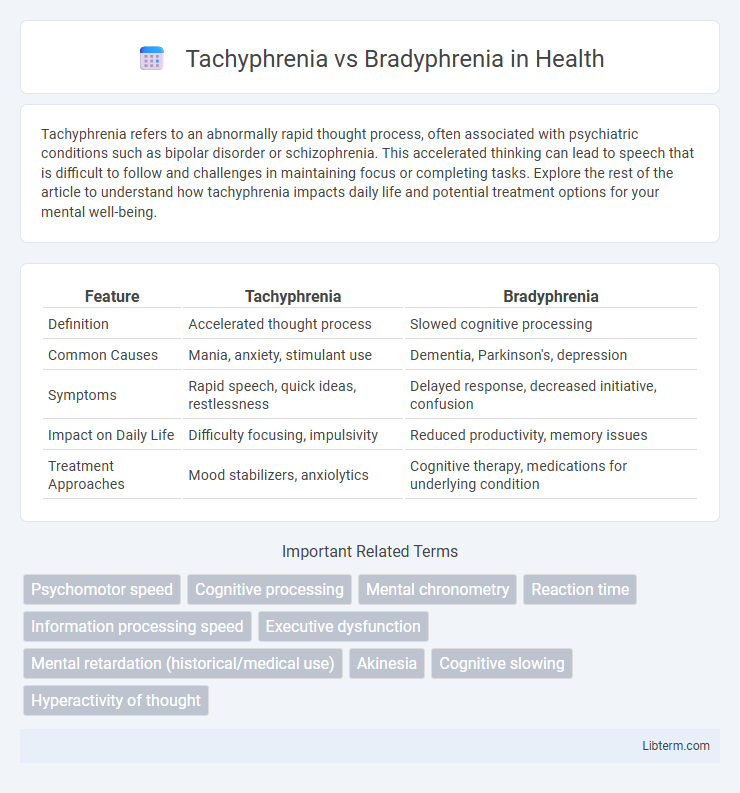Tachyphrenia refers to an abnormally rapid thought process, often associated with psychiatric conditions such as bipolar disorder or schizophrenia. This accelerated thinking can lead to speech that is difficult to follow and challenges in maintaining focus or completing tasks. Explore the rest of the article to understand how tachyphrenia impacts daily life and potential treatment options for your mental well-being.
Table of Comparison
| Feature | Tachyphrenia | Bradyphrenia |
|---|---|---|
| Definition | Accelerated thought process | Slowed cognitive processing |
| Common Causes | Mania, anxiety, stimulant use | Dementia, Parkinson's, depression |
| Symptoms | Rapid speech, quick ideas, restlessness | Delayed response, decreased initiative, confusion |
| Impact on Daily Life | Difficulty focusing, impulsivity | Reduced productivity, memory issues |
| Treatment Approaches | Mood stabilizers, anxiolytics | Cognitive therapy, medications for underlying condition |
Understanding Tachyphrenia and Bradyphrenia
Tachyphrenia refers to an abnormally rapid thought process, often characterized by accelerated speech and racing ideas, commonly seen in conditions like mania or psychosis. Bradyphrenia involves a significant slowing of cognitive functions, leading to delayed thought processing and reduced mental clarity, frequently associated with neurodegenerative diseases such as Parkinson's or Alzheimer's. Differentiating between tachyphrenia and bradyphrenia is essential for accurate diagnosis and targeted treatment in neurological and psychiatric disorders.
Key Differences Between Tachyphrenia and Bradyphrenia
Tachyphrenia is characterized by an abnormally rapid flow of thoughts, often leading to pressured speech and difficulty maintaining focus, while bradyphrenia involves a noticeable slowness in cognitive processes, affecting attention, memory, and decision-making. Key differences include tachyphrenia's association with conditions like mania and schizophrenia, contrasted with bradyphrenia's prevalence in neurodegenerative disorders such as Parkinson's disease and Alzheimer's disease. Understanding these distinctions aids in accurate diagnosis and targeted treatment strategies for cognitive and psychiatric interventions.
Causes of Tachyphrenia
Tachyphrenia, characterized by an abnormally rapid thought process, often results from conditions such as anxiety disorders, mania, or the effects of stimulant drugs like amphetamines. Neurochemical imbalances involving excessive dopamine activity in the brain's prefrontal cortex contribute significantly to this accelerated cognition. In contrast, bradyphrenia presents as slowed mental processing linked primarily to neurodegenerative diseases such as Parkinson's or Alzheimer's.
Causes of Bradyphrenia
Bradyphrenia, characterized by slowed cognitive processing, is often caused by neurological disorders such as Parkinson's disease, Alzheimer's disease, and other forms of dementia. It can also result from brain injuries, chronic psychiatric conditions like depression, and the effects of certain medications or substance abuse. Unlike tachyphrenia, which involves rapid thought processes commonly seen in mania or anxiety disorders, bradyphrenia reflects impaired neural function and reduced mental speed.
Clinical Symptoms and Presentation
Tachyphrenia presents with rapid thought processes, pressured speech, and distractibility, commonly seen in manic episodes of bipolar disorder. Bradyphrenia is characterized by slowed mental processing, reduced speech output, and impaired attention, often associated with neurodegenerative diseases like Parkinson's and Alzheimer's. Clinical presentation distinguishes tachyphrenia by accelerated cognition, whereas bradyphrenia manifests as cognitive sluggishness and delayed responses.
Diagnostic Approaches
Diagnostic approaches for tachyphrenia prioritize neuropsychological assessments targeting rapid thought processing and cognitive acceleration, often utilizing reaction time tests and verbal fluency measures. In contrast, bradyphrenia diagnosis involves comprehensive cognitive evaluations emphasizing slowed information processing speed, using tools such as the Trail Making Test and processing speed index from IQ batteries. Neuroimaging techniques like fMRI and PET scans complement both diagnoses by identifying underlying neurological patterns associated with either accelerated or decelerated cognitive function.
Impact on Daily Functioning
Tachyphrenia, characterized by accelerated thought processes, can lead to impulsivity and difficulty in sustaining attention, often disrupting daily tasks and decision-making. Bradyphrenia involves slowed cognitive processing, which impairs the ability to respond quickly to environmental stimuli and complete activities in a timely manner. Both conditions significantly affect executive functioning, reducing efficiency in work, social interactions, and routine problem-solving.
Associated Medical Conditions
Tachyphrenia is often associated with psychiatric disorders such as schizophrenia and bipolar disorder, where rapid thought processes may lead to disorganized thinking and impaired judgment. Bradyphrenia commonly occurs in neurodegenerative diseases like Parkinson's disease and Alzheimer's disease, characterized by slowed cognitive processing and decreased mental agility. Both conditions serve as clinical indicators of underlying neurological or psychiatric pathologies requiring targeted diagnostic evaluation.
Treatment Options and Management
Treatment options for tachyphrenia often involve cognitive behavioral therapy and stimulant medications to enhance rapid thought processing and improve attention. Bradyphrenia management typically includes dopamine agonists and cognitive rehabilitation strategies to counteract slowed mental activity and enhance cognitive function. Both conditions benefit from personalized neuropsychological assessment to tailor interventions that address specific cognitive impairments effectively.
Prognosis and Long-Term Outcomes
Tachyphrenia, characterized by abnormally rapid thought processes, often associates with conditions like mania, generally showing a prognosis that improves with appropriate treatment and stabilization. Bradyphrenia involves slowed cognitive processing, common in neurodegenerative disorders such as Parkinson's disease and dementia, usually indicating a progressive decline with poor long-term outcomes without intervention. Long-term prognosis depends on underlying causes, early diagnosis, and therapeutic management, with tachyphrenia typically having a more favorable outcome compared to the persistent cognitive impairments seen in bradyphrenia.
Tachyphrenia Infographic

 libterm.com
libterm.com